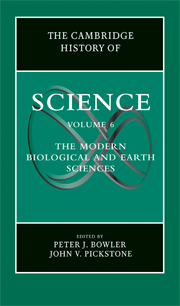Book contents
- Frontmatter
- 1 Introduction
- PART I WORKERS AND PLACES
- PART II ANALYSIS AND EXPERIMENTATION
- PART III NEW OBJECTS AND IDEAS
- 20 Plate Tectonics
- 21 Geophysics and Geochemistry
- 22 Mathematical Models
- 23 Genes
- 24 Ecosystems
- 25 Immunology
- 26 Cancer
- 27 The Brain and the Behavioral Sciences
- 28 History of Biotechnology
- PART IV SCIENCE AND CULTURE
- Index
- References
25 - Immunology
from PART III - NEW OBJECTS AND IDEAS
Published online by Cambridge University Press: 28 November 2009
- Frontmatter
- 1 Introduction
- PART I WORKERS AND PLACES
- PART II ANALYSIS AND EXPERIMENTATION
- PART III NEW OBJECTS AND IDEAS
- 20 Plate Tectonics
- 21 Geophysics and Geochemistry
- 22 Mathematical Models
- 23 Genes
- 24 Ecosystems
- 25 Immunology
- 26 Cancer
- 27 The Brain and the Behavioral Sciences
- 28 History of Biotechnology
- PART IV SCIENCE AND CULTURE
- Index
- References
Summary
IMMUNOLOGY
“Immunity,” taken broadly, refers to a cluster of natural phenomena observed first in the field, then in the clinic, and finally in the laboratory. It had been known since antiquity that injections of small doses of poison could prevent unexpected larger doses from causing harm (preventive immunity), that there were some diseases that never afflicted a person more than once (acquired immunity), and that certain individuals were more disposed than others to stay free from infectious diseases (natural immunity). Although it is customary to credit the British physician Edward Jenner with the invention of the first effective preventive procedure against smallpox (later known as vaccination), inhalation or inoculation of powdered scabs from smallpox lesions seems to have been part of ethnomedical practice long before then and was even practiced by the European gentry throughout most of the eighteenth century. Jenner’s technique – inoculating cowpox matter to prevent smallpox – was first published in 1798 and won rapid acceptance, probably because his methodical investigation suited an age permeated by Enlightenment optimism toward science. Even so, the next advance in understanding immunity came nearly a century later within the context of the new germ theory of disease.
- Type
- Chapter
- Information
- The Cambridge History of Science , pp. 467 - 485Publisher: Cambridge University PressPrint publication year: 2009



